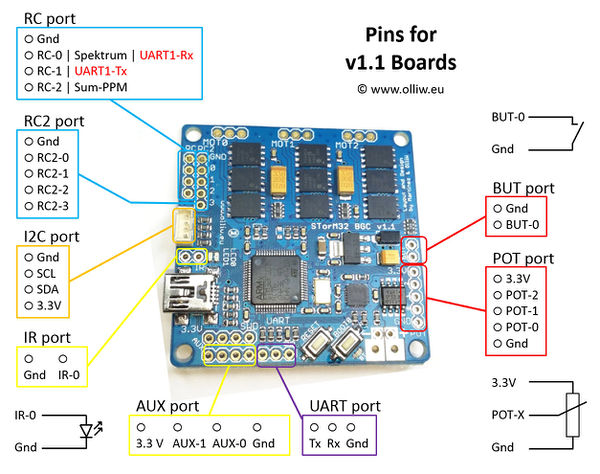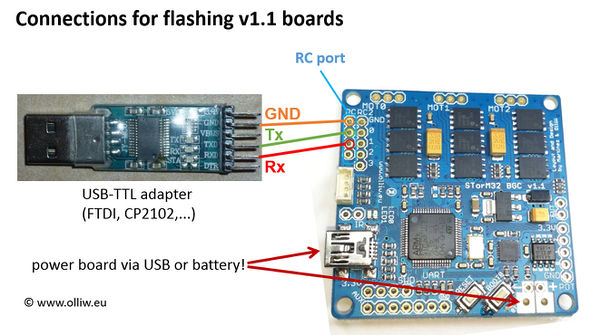Docu for MultiRotorMania board(s): Difference between revisions
Jump to navigation
Jump to search
(Created page with "This page provides documentation for the STorM32-BGC board sold by [http://multirotormania.com/ Multi Rotor Mania]. == Dos and Don'ts == Please read the tutorial's Getting...") |
No edit summary |
||
| (2 intermediate revisions by the same user not shown) | |||
| Line 30: | Line 30: | ||
* the board comes without firmware | * the board comes without firmware | ||
* the pins on connector I2C#2 are reversed as with respect to connector I2C | * the pins on connector I2C#2 are reversed as with respect to connector I2C | ||
* on some boards the diode required for | * on some boards the diode required for running a bluetooth module is not populated | ||
== Specifications == | == Specifications == | ||
| Line 39: | Line 39: | ||
== Pins and Connectors == | == Pins and Connectors == | ||
[[File:Stom32-bgc-v110-ports-and-connections-01.jpg|600px]] | |||
== Flashing Firmware == | == Flashing Firmware == | ||
| Line 44: | Line 46: | ||
Follow the instructions for {{WARNING|v1.1 boards}} in the [[How to flash firmware]] manual. | Follow the instructions for {{WARNING|v1.1 boards}} in the [[How to flash firmware]] manual. | ||
[[File:Stom32-bgc-v110-flashing-w-usbttladapter-connections-01.jpg|600px]] | |||
Latest revision as of 10:42, 25 October 2014
This page provides documentation for the STorM32-BGC board sold by Multi Rotor Mania.
Dos and Don'ts
Please read the tutorial's Dos and Don'ts.
The board is shipped without firmware, it hence needs first to be flashed (see here).
Also, the pins on the connector I2C#2 on the bottom side are reversed as compared to those of connector I2C. Pay attention to that when connecting a second IMU to the I2C#2 port. Fortunately, it is relatively easy to swap the pins on the connectors of the supplied IMU cables.
Shop Link
http://multirotormania.com/controllers/42-stormbgc-32-bit-3-axis-controller-wimu.html
Board Configuration
- board version: v1.1
- board color: blue
- motor drivers in DFN packages: yes
- on-board MPU: yes
- on-board bluetooth module: no
- I2C plug type: picoblade (1.25mm JST)
- I2C#2 plug type: picoblade (1.25mm JST)
- pin headers: no
Included accessories:
- MPU module
- cable with connectors for MPU module
Points to note:
- the board comes without firmware
- the pins on connector I2C#2 are reversed as with respect to connector I2C
- on some boards the diode required for running a bluetooth module is not populated
Specifications
- supply voltage: 6 - 18 V or 2 - 4S
- motor current: max. 1.5 A per motor
Comment: This is not yet fully exploited, motors with resistances of 12 Ohm or larger have been tested to be well handled at 4S (see here, here), motors with 10 Ohm may be handled with care (see here and here). - board dimensions: 50 mm x 50 mm, 45 mm bolt to bolt, holes Ø3 mm
Pins and Connectors
Flashing Firmware
Follow the instructions for v1.1 boards in the How to flash firmware manual.

